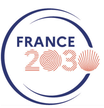|
13 videos available for this event!
|
Random Geometry
Géométrie aléatoire
17 – 21 January 2022
|
Scientific Committee
Comité scientifique Omer Angel (University of British Columbia) |
Organizing Committee
Comité d’organisation Nicolas Curien (Université Paris-Saclay) |
|
The area of random geometry has known several important developments in the last ten years. This area lies at the boundary between probability theory, combinatorics and theoretical physics, and gives rise to fruitful interactions between researchers coming from these different fields. In particular, the study of planar maps, which are graphs drawn on the sphere, has been of interest for long both in combinatorics, in connection with the celebrated four color theorem, and in theoretical physics, in the setting of two-dimensional quantum gravity. The continuous model called the Brownian map has been shown to be the universal scaling limit of large planar maps chosen uniformly at random in a suitable combinatorial class such as the class of triangulations. A program connecting the Brownian map with Liouville quantum gravity has been developed in a series of papers of Miller and Sheffield. More recently, the work of several authors has shown that the Liouville quantum gravity metric can be defined directly from the two-dimensional Gaussian free field. On the other hand, fascinating results have been obtained for maps on surfaces of higher genus, especially when the genus tends to infinity. Still many questions remain open, concerning in particular the extension of these models to higher dimensions, or the conformal embeddings of random planar maps. The workshop will gather the most prominent specialists coming from probability theory, combinatorics and theoretical physics, who will present the recent achievements and discuss further developments.
|
Le domaine de la géométrie aléatoire a connu plusieurs développements importants dans les dix dernières années. Ce sujet se trouve à la frontière entre théorie des probabilités, combinatoire et physique théorique, et donne lieu à des interactions fructueuses entre spécialistes de ces différents domaines. En particulier, l’étude des cartes planaires, qui sont des graphes dessinés sur la sphère, est depuis longtemps une question importante en combinatoire mais aussi en physique théorique, dans le cadre de la gravité quantique en dimension deux. Le modèle continu appelé la carte brownienne est apparu comme la limite d’échelle universelle des grandes cartes planaires aléatoires choisies au hasard dans une classe combinatoire, par exemple la classe des triangulations. Un programme reliant la carte brownienne à la gravité quantique de Liouville a été développé dans une série d’articles de Miller et Sheffield. Tout récemment, des travaux de plusieurs auteurs ont montré que la distance de la gravité quantique de Liouville peut être définie directement à partir du champ libre gaussien. Par ailleurs, des résultats surprenants ont été obtenus pour les cartes sur des surfaces de genre supérieur, en particulier quand le genre tend vers l’infini. Il reste néanmoins beaucoup de questions ouvertes, concernant notamment l’extension des modèles en dimension plus grande, ou les plongements conformes de cartes planaires aléatoires. Le colloque rassemblera les spécialistes les plus éminents venant de théorie des probabilités, de combinatoire ou de physique théorique, qui présenteront les progrès récents et discuteront les déeloppements à venir.
|
Marie Albenque (CNRS, École Polytechnique) Study of the sign clusters in the Infinite Ising-weighted triangulations
Jérémie Bettinelli (CNRS Ecole Polytechnique Palaiseau) Nonbijective scaling limit of maps via restriction
Jacopo Borga (University of Zurich) The skew Brownian permuton: a new universal limit for random constrained permutations and its connections with Liouville quantum gravity
Gaetan Borot (Humboldt-University of Berlin) Maps, Hurwitz numbers and formulas for free probability at all genera
Jérémie Bouttier (CEA Saclay et ENS Lyon) Multicritical Schur measures
Timothy Budd (Radboud University) Random hyperbolic surfaces
Thomas Budzinski (University of British Columbia) Markovian triangulations and robust convergence to the UIPT
Alessandra Caraceni (University of Oxford) Growing maps face by face and applications to flip chains
Guillaume Chapuy (CNRS IRIF – Université de Paris) Some questions on the Brownian Map motivated by its higher-genus analogues
Maciej Dołęga (Institute of Mathematics Polish Academy) Bijections for maps on non-oriented surfaces
Bertrand Duplantier (IPhT – Université Paris-Saclay) TBC
Elba Garcia-failde (IRIF – IHES Université Paris-Saclay) Generalised Kontsevich graphs, topological recursion and r-spin intersection numbers
Eric Fusy (CNRS LIGM Université Gustave Eiffel) Maps of unfixed genus and blossoming trees
Colin Guillarmou (CNRS Université Paris-Saclay) Segal Axioms and the conformal bootstrap for all surfaces in Liouville CFT
Igor Kortchemski (CNRS, École Polytechnique) Sparse random maps
Baptiste Louf (University of Uppsala) Unicellular maps and hyperbolic surfaces in high genus
Grégory Miermont (ENS Lyon) On the enumeration of random maps with three tight boundaries and its probabilistic consequences
Armand Riera (Université Paris-Saclay) Scaling limit of planar maps with large faces
Sigurður Stefánsson (University of Iceland) Random causal maps
Meltem Unel (University of Copenhagen) Height coupled trees
Vincent Vargas (CNRS, ENS Paris) Liouville conformal field theory: from probability theory to the conformal bootstrap






